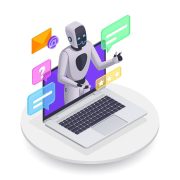What Are Bots and How Are They Used on the Internet?
What Are Bots and How Are They Used on the Internet?
The internet runs on millions of automated programs, many of which you may not even notice. These programs are known as bots (short for “robots”). Bots are software applications designed to perform repetitive tasks automatically, without direct human intervention. While they can make online experiences faster and smarter, not all bots are beneficial. Some are used maliciously, causing harm to businesses and individuals.
In this article, we’ll explore what bots are, their positive uses, and the negative impact they can have on the internet.
What Are Bots?
A bot is simply an automated program that can interact with systems, websites, and users. Bots run scripts or commands designed to perform tasks such as browsing websites, fetching data, sending messages, or even simulating human behavior.
They operate much faster than humans and can handle large volumes of work in a very short time, making them both powerful tools and potential threats.
Positive Uses of Bots
Not all bots are bad. In fact, some are essential for making the internet work as smoothly as it does today. Here are the most common beneficial uses of bots:
1. Search Engine Crawlers
Bots like Googlebot and Bingbot scan websites to index their content for search engines. Without them, your website would never appear in Google search results.
2. Chatbots and Virtual Assistants
Customer service chatbots on websites (like those on Web Register Limited) help businesses answer frequently asked questions, provide support, and improve customer engagement.
3. E-commerce and Travel Bots
Price-comparison bots help users find the best deals online. Travel platforms use bots to gather flight and hotel data instantly, making searches faster.
4. Trading Bots
In forex, crypto, and stock markets, bots execute trades automatically, helping traders respond to market changes in real time.
5. Automation Tools
Bots are also used for automating repetitive business tasks like sending reminders, scheduling posts on social media, and collecting data from websites.
Negative Uses of Bots
Unfortunately, not all bots are designed with good intentions. Malicious bots are responsible for some of the biggest cybersecurity threats today. Examples include:
1. Spam Bots
They send unwanted emails, flood websites with fake comments, or push malicious links.
2. Credential Stuffing Bots
These bots attempt to break into accounts using stolen usernames and passwords from data breaches.
3. Scraping Bots
Some bots steal content, pricing data, or product information from websites without permission, hurting businesses.
4. DDoS (Distributed Denial of Service) Bots
Malicious bots can overload a website or server with fake traffic, causing downtime and loss of revenue.
5. Fake Social Media Bots
These bots create fake likes, followers, or comments on social media, spreading misinformation or manipulating trends.
How to Protect Your Website from Malicious Bots
If you own a website, it’s essential to secure it against harmful bot activity. At Web Register Limited, we provide secure hosting and website protection solutions to keep your online business safe. Some common protections include:
-
Installing firewalls to block suspicious traffic.
-
Using CAPTCHA to differentiate between humans and bots.
-
Monitoring server logs for unusual activity.
-
Leveraging bot management tools like Imunify360 or Cloudflare.
-
Keeping your website software updated.
✅ SEO Meta Description:
Discover what bots are, how they work, and their positive and negative uses on the internet. Learn how Web Register Limited can help protect your website from harmful bots.






















